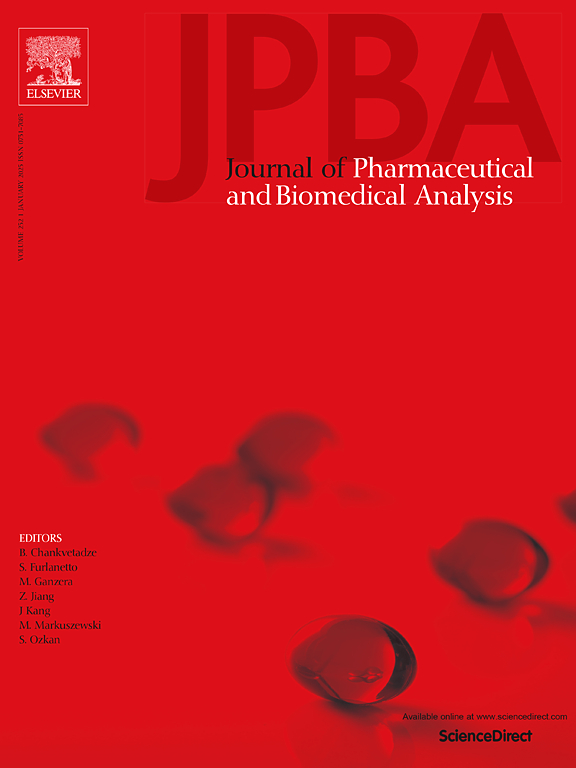盐酸戊乙奎醚通过mTOR/Keap1/Nrf2信号通路调节自噬对lps诱导的急性肺损伤的作用机制研究
IF 3.1
3区 医学
Q2 CHEMISTRY, ANALYTICAL
Journal of pharmaceutical and biomedical analysis
Pub Date : 2025-04-27
DOI:10.1016/j.jpba.2025.116938
引用次数: 0
摘要
急性肺损伤(Acute lung injury, ALI)是一种以肺部炎症和水肿为特征的临床综合征,可导致氧合受损和呼吸衰竭。盐酸戊乙奎醚(PHC)具有抗胆碱能、抗炎和抗氧化的特性。本文研究了PHC对ALI的保护作用,并探讨了其作用机制。采用LPS诱导建立ALI模型,进行体内和体外实验。PHC干预后,采用病理切片检查、小鼠肺损伤评分、ELISA法检测氧化应激标志物髓过氧化物酶(MPO)、丙二醛(MDA)、超氧化物歧化酶(SOD)、谷胱甘肽过氧化物酶(GSH-Px)及炎性细胞因子TNF-α、IL-1β、IL-18水平。采用免疫印迹法和免疫荧光法检测自噬标志物和mTOR/Keap1/Nrf2信号通路。为了证实自噬在PHC对ALI的保护作用中的作用,我们将PHC与雷帕霉素(Rapamycin, RAPA)或3-甲基腺嘌呤(3-MA)联合给予模型组,并评估上述参数。结果表明,lps诱导的ALI模型肺组织病理损伤明显,肺组织和血清中MPO、MDA、TNF-α、IL-1β和IL-18水平升高,SOD和GSH-Px水平降低。这些改变在PHC治疗后全部逆转。此外,与ALI组相比,PHC可逆转LPS诱导的mTOR/Keap1/Nrf2和自噬蛋白LC3、Beclin-1和p62的表达。mTOR抑制剂(自噬诱导剂RAPA)治疗可阻断PHC对肺损伤、mTOR/Keap1/Nrf2信号通路和自噬的保护作用,而与自噬抑制剂3-MA联合治疗对ALI有显著的保护作用。结果表明,PHC对ALI具有显著的保护作用,可能通过调节mTOR/Keap1/Nrf2信号通路抑制自噬来实现。本文章由计算机程序翻译,如有差异,请以英文原文为准。
Study on the mechanism of action of Penehyclidine hydrochloride on LPS-induced acute lung injury by regulating autophagy through the mTOR/Keap1/Nrf2 signaling pathway
Acute lung injury (ALI) is a clinical syndrome characterized by pulmonary inflammation and edema, leading to impaired oxygenation and respiratory failure. Penehyclidine hydrochloride (PHC) has anticholinergic, anti-inflammatory, and antioxidant properties. In this paper, we investigated the protective role of PHC in ALI and explored its mechanism of action. Both in vivo and in vitro experiments were performed using LPS induction to establish an ALI model. Following PHC intervention, the assessment of lung injury was conducted using pathological section examination, mouse lung injury scoring, and ELISA to measure oxidative stress markers including myeloperoxidase (MPO), malondialdehyde (MDA), Super Oxide Dismutase (SOD), and Glutathione Peroxidase (GSH-Px), as well as inflammatory cytokine levels of TNF-α, IL-1β, and IL-18. Immunoblotting and immunofluorescence assays were employed to detect autophagy markers and the mTOR/Keap1/Nrf2 signaling pathway. To confirm the role of autophagy in the protective effects of PHC against ALI, we administered PHC in combination with Rapamycin (RAPA) or 3-Methyladenine (3-MA) to the model groups and evaluated the aforementioned parameters. Our findings revealed that in the LPS-induced ALI model, there was significant pulmonary histopathological damage and increased levels of MPO, MDA, TNF-α, IL-1β, and IL-18, along with decreased levels of SOD and GSH-Px in lung tissue or serum. These alterations were all reversed following PHC treatment. Additionally, compared to the ALI group, PHC administration reversed the expression of mTOR/Keap1/Nrf2 and autophagy proteins LC3, Beclin-1 and p62 induced by LPS. Treatment with the mTOR inhibitor (autophagy inducer RAPA) blocked the protective effects of PHC on lung injury, the mTOR/Keap1/Nrf2 signaling pathway, and autophagy, while co-treatment with the autophagy inhibitor 3-MA showed a significant protective effect on ALI. The results suggest that PHC has a notable protective effect on ALI, which may be achieved by modulating the mTOR/Keap1/Nrf2 signaling pathway to inhibit autophagy.
求助全文
通过发布文献求助,成功后即可免费获取论文全文。
去求助
来源期刊
CiteScore
6.70
自引率
5.90%
发文量
588
审稿时长
37 days
期刊介绍:
This journal is an international medium directed towards the needs of academic, clinical, government and industrial analysis by publishing original research reports and critical reviews on pharmaceutical and biomedical analysis. It covers the interdisciplinary aspects of analysis in the pharmaceutical, biomedical and clinical sciences, including developments in analytical methodology, instrumentation, computation and interpretation. Submissions on novel applications focusing on drug purity and stability studies, pharmacokinetics, therapeutic monitoring, metabolic profiling; drug-related aspects of analytical biochemistry and forensic toxicology; quality assurance in the pharmaceutical industry are also welcome.
Studies from areas of well established and poorly selective methods, such as UV-VIS spectrophotometry (including derivative and multi-wavelength measurements), basic electroanalytical (potentiometric, polarographic and voltammetric) methods, fluorimetry, flow-injection analysis, etc. are accepted for publication in exceptional cases only, if a unique and substantial advantage over presently known systems is demonstrated. The same applies to the assay of simple drug formulations by any kind of methods and the determination of drugs in biological samples based merely on spiked samples. Drug purity/stability studies should contain information on the structure elucidation of the impurities/degradants.

 求助内容:
求助内容: 应助结果提醒方式:
应助结果提醒方式:


